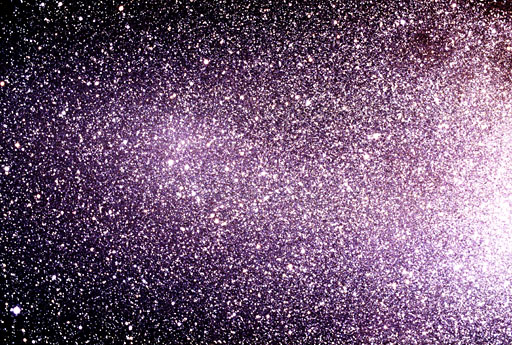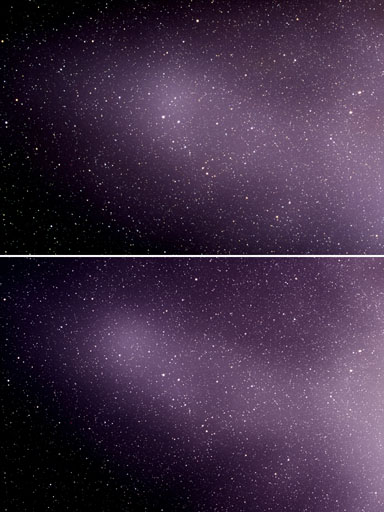

Gegenschein
Counter-glow in Capricornus
leyenda si/no
| Fecha: | 15./21.08.04
| Hora: | 22:13 / 0:04 UT
| Exposición: | 77 min / 45 min
|
| Campo visual: | 44o x 30o
| Emulsion: | Fuji Provia 400F / Kodak E200
| Filtro: | none
|
| Instrumento: | f=35mm 1/4.0
(reduced from 1/2.0)
| Lugar: | Hakos, Namibia
| Observador: | Till Credner
| |
|
explicación
|
What is the gegenschein?
The gegenschein, the german word for counter glow, is a faint and
diffuse but extended glow in the night sky, hardly visible to the
naked eye only at very dark sites. It is best seen at
local midnight, since the position is always the antisolar point, the
direction just 180 degrees opposite of the sun in the sky (anthelion).
Dust in the plane of our planetary system is scattering sunlight.
This makes the diffuse glow along the ecliptic of the zodiacal light
close to dusk and dawn, but also the lightbridge and the gegenschein.
Since dust scatters favorable into backward direction there appears
a brighter patch, the gegenschein, in the anthelion.
Observation
The two images above, taken about five days apart in August 2004,
show the diffuse night sky brightness in the constellation of
Capricornus. On the right hand side are the eastern outskirts of
the milky way and just left of it some diffuse background structures
probably because of remaining integrated star flux. These background
structures are more or less identical on both images whereas the
diffuse patch close to anthelion shifts about five degrees, just the
amount the sun, and so the anthelion, shifts along the ecliptic in
five days. It is not quite clear if the diffuse component between
Milkyway and Gegenschein might belong to the Light-bridge. The plane
of the ecliptic might favour this, however, the patterns seem to be
fixed in the five day intervall. It is probably both: Light-bridge and
integrated star flux superposed.
A more close inspection of the gegenschein's central position
shows a considerable deviation of about 1 or 1.5 degrees from the
anthelion to the south. The longitude along the ecliptic matches quite
well with the anthelion (within an accuracy of roughly 0.5 degrees).
Explanation
An offset in ecliptical latitude was also reported by other observers
and is commonly explained by an inclination of the circumsolar dust cloud
with respect to the ecliptic (see discussion for example by James et al.
1997). The inclination is about 2 degrees but there is many uncertainty
in this number and still the question of an existance of a
stable symmetry at all. Asteroidal dust bands can influence the observed
position of the gegenschein considerably as shown by Tadashi et al. 2003.
Some words for doing proper imaging of the gegenschein and the following
image processing:
Image aquisition
- You need a very dark sky.
- Any cloud may alter the data significantly.
- Select observing site where the anthelion has a high elevation
to avoid airglow and light pollution as much as possible.
- Choose date when the anthelion is high and not close to the galactic
plane or bright planets.
- Expose around local midnight when the anthelion is high.
- Reduce aperture to minimize vignetting (with CCD
you have to do proper flat-fielding).
- Decenter anthelion to avoid confusion with possible vignetting.
- Long total integration times to optimize the signal to noise ratio.
- Observe at different dates to distinguish between fixed background
patterns and the shifting gegenschein.
Image processing
| The above image is heavily processed and does not resemble the view by
naked eye. The background intensity (but not the stars!) was
smoothed and contrast enhanced to bring out the elusive gegenschein well.
The filter radius for smoothing
was about 2 degrees, so all possible structures with sizes of 2 degrees or
smaller are gone. (Nevertheless, the accuracy for the centroid position of
the gegenschein is better than 2 degrees, roughly about 0.5 degrees)
|

This is a single original, but constrast enhanced, exposure showing stars
and gegenschein with the proper intensity relation.
|
Processing steps:
- Align exposures.
- Remove stars on each frame with a low frequency pass filter, for
example a broad "dust/scratches" filter in Photoshop, this will
also smooth the background heavily. Find a good compromise for
the filter radius: maximise the size to remove all stars as good as
possible, but minimize the size to maintain background structures.
- Add consecutive exposures.
- Increase contrast to show the gegenschein well.
- Add one of the original aligned images to see the stars again.
|
See also:
All Sky fisheye view 22.08.2004 showing the
light brigde with gegenschein
Zodiacal light, evening of 16.08.2004
Brorsen, M. Th., "Über den Gegenschein des Zodiakallichts", 1856AN.....42..219B
Tadashi et al., "The influence of the brightness of the asteroidal dust bands on the
gegenschein", 2003Icar..162..337M
James et al., "The morphology and brightness of the zodiacal light and
gegenschein", 1997MNRAS.288.1022J
Leinert et al., "The 1997 reference of diffuse night sky brightness", 1998A&AS..127....1L

